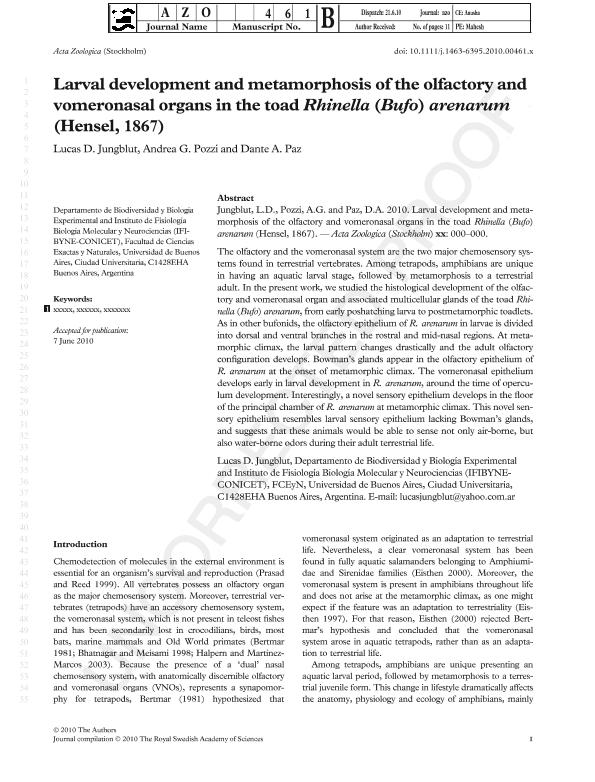Artículo
Larval development and metamorphosis of the olfactory and vomeronasal organs in the toad Rhinella (Bufo) arenarum (Hensel, 1867)
Fecha de publicación:
07/2010
Editorial:
Wiley
Revista:
Acta Zoologica
ISSN:
0001-7272
Idioma:
Inglés
Tipo de recurso:
Artículo publicado
Clasificación temática:
Resumen
The olfactory and the vomeronasal system are the two major chemosensory systems found in terrestrial vertebrates. Among tetrapods, amphibians are unique in having an aquatic larval stage, followed by metamorphosis to a terrestrial adult. In the present work, we studied the histological development of the olfactory and vomeronasal organ and associated multicellular glands of the toad Rhinella (Bufo) arenarum, from early poshatching larva to postmetamorphic toadlets. As in other bufonids, the olfactory epithelium of R. arenarum in larvae is divided into dorsal and ventral branches in the rostral and mid-nasal regions. At metamorphic climax, the larval pattern changes drastically and the adult olfactory configuration develops. Bowman’s glands appear in the olfactory epithelium of R. arenarum at the onset of metamorphic climax. The vomeronasal epithelium develops early in larval development in R. arenarum, around the time of operculum development. Interestingly, a novel sensory epithelium develops in the floor of the principal chamber of R. arenarum at metamorphic climax. This novel sensory epithelium resembles larval sensory epithelium lacking Bowman’s glands, and suggests that these animals would be able to sense not only air-borne, but also water-borne odors during their adult terrestrial life.
Palabras clave:
Olfactory Neurons
,
Tadpoles
,
Amphibia
,
Nasal Sensory
Archivos asociados
Licencia
Identificadores
Colecciones
Articulos(IFIBYNE)
Articulos de INST.DE FISIOL., BIOL.MOLECULAR Y NEUROCIENCIAS
Articulos de INST.DE FISIOL., BIOL.MOLECULAR Y NEUROCIENCIAS
Citación
Jungblut, Lucas David; Pozzi, Andrea Gabriela; Paz, Dante Agustin; Larval development and metamorphosis of the olfactory and vomeronasal organs in the toad Rhinella (Bufo) arenarum (Hensel, 1867); Wiley; Acta Zoologica; 92; 4; 7-2010; 305-315
Compartir
Altmétricas




